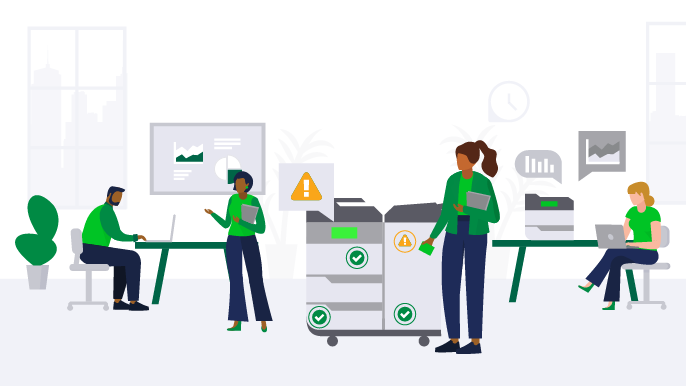Democratizing data to advance your digital transformation journey
Data is only as valuable as its application. At Lexmark, our digital transformation journey is made possible by making data available across the organization.
By Dan Seevers, Director of Data Science & Analytics and Development Operations at Lexmark
April 12, 2021

Accelerated by the impact of the pandemic, digital transformation — including the adoption of disruptive technologies like cloud, the Internet of Things (IoT), advanced analytics and intelligent automation — is helping drive innovation and opening the door to more possibilities than ever before. As IoT infrastructure becomes widespread and scalable, more organizations have access to vast amounts of real-time data. According to the tech analyst firm IDC, the amount of data created over the next three years will be more than in the past 30 years combined.
However, data is only as valuable to an organization as its application.
A NewVantage Partners survey from 2021 found that even as investment levels grew to record levels, companies are “continuing to struggle to derive value from their Big Data and AI investments and to become data-driven organizations.” Even with more data than ever before, organizations will need help cutting through the noise of their data to identify the “golden nuggets” of insights that have the ability drive true organizational change.
At Lexmark, our digital transformation journey was only made possible by breaking down internal silos and making data available across the organization. Too often, silos can hamper growth and efficiency in your business, resulting in duplicated efforts, a lack of synergy and missed opportunities. While it’s a common practice to make proprietary data available only to those who need it, we’ve found that enabling greater organizational access can enhance project ideas and facilitate better alignment on business priorities.
Through many years of honing our approach, Lexmark has worked to understand the data-to-value journey and how it impacts our customers. We currently manage more than 1 million connected, IoT-enabled printers and devices, which translates to more than 1 TB of data a week — a huge amount of data that must be handled securely and efficiently. Several years ago, we realized that all the answers to our big business questions — such as how to predict the precise moment to ship a toner cartridge to a customer — were potentially in that data, if only we understood how to unlock the insights.
Lexmark's digital transformation journey was only made possible by breaking down internal silos and making data available across the organization.
This was the motivation behind the Lexmark Data Science and Analytics Center, a space dedicated to building collaboration and inclusion within the Lexmark community while amplifying data as an asset. I discussed this in detail on IDC's Future of Intelligence podcast with IDC's Joseph Pucciarelli, Group Vice President and IT Executive Advisor, and Dan Vesset, Group Vice President, Analytics and Information Management.
Although Lexmark is known for its strong engineering and product development skills, we wanted it to be clear that we were breaking down silos and making analytics accessible across the organization. Combining skills in programming, statistics and business acumen, the team was tasked with leveraging data science and analytics to solve the company’s most difficult challenges. In the process, the center became a resource for the entire company to work together and co-create new value for our customers.
While many innovation teams operate in stealth mode, our team is much more collaborative, working with other business units to understand their problems before developing data models to assess and address their questions. None of this could take place without the right culture to support the transformation and enable greater data sharing.
Significant change to become a data-centric organization doesn’t happen overnight. Change at Lexmark is an iterative process that has also transformed our thinking and culture, and the value we have seen has been well worth the journey.
If you are looking for advice about how to jump-start your company’s digital transformation, consider these suggestions:
- Adopt solutions-oriented terms. Ditch the industry jargon for terms that clearly articulate the goal you are driving towards. For example, we at Lexmark stopped calling next-gen analytics “proofs of concept,” and now call them “proofs of value,” which helps to show clear ROI and the ability to materially impact the business.
- Look for ways to connect data across the organization. Since data typically comes from disparate systems, we focused on new value creation opportunities by combining and transforming data sets from different parts of the business. For example, improving supply chain metrics helps improve finance metrics. Our center works with a cross-functional team to identify a funnel of potential projects through this collaborative process.
- Ask business-driven questions rather than open-ended ones. Too often, data engineers ask their leadership, “What data do you need?,” instead of asking, “What decisions do you need to make?” Framing questions the correct way helps set the stage for a more data-driven company and data-literate working culture that turns insights into actions. Additionally, once you become accustomed to analyzing a problem from a multidimensional lens, then broader insights can quickly be turned into new value opportunities. In a post-COVID environment, our ability to remove uncertainty, streamline operations and increase productivity can help businesses stand out even more.

Learn more by listening to my interview on IDC's Future of Intelligence podcast.

Dan Seevers is the director of data science and analytics at Lexmark, where he also is manager of D3.Labs, Lexmark's UX center focused on using data-driven Design Thinking to create intuitive and intelligent products. Seevers has a broad range of experience between Lexmark and IBM in the fields of product development, operations, and data science and analytics. He holds a bachelor’s degree in mechanical engineering from Missouri University of Science and Technology; master’s degrees in manufacturing technology, diplomacy and international commerce from Eastern Kentucky University and the University of Kentucky; and a Ph.D. in mechanical engineering from UK. Seevers has a passion for thought leadership in decision sciences, risk modeling, value creation models, and product design and delivery. He is also committed to the advancement of STEM-related topics in our future leaders.



